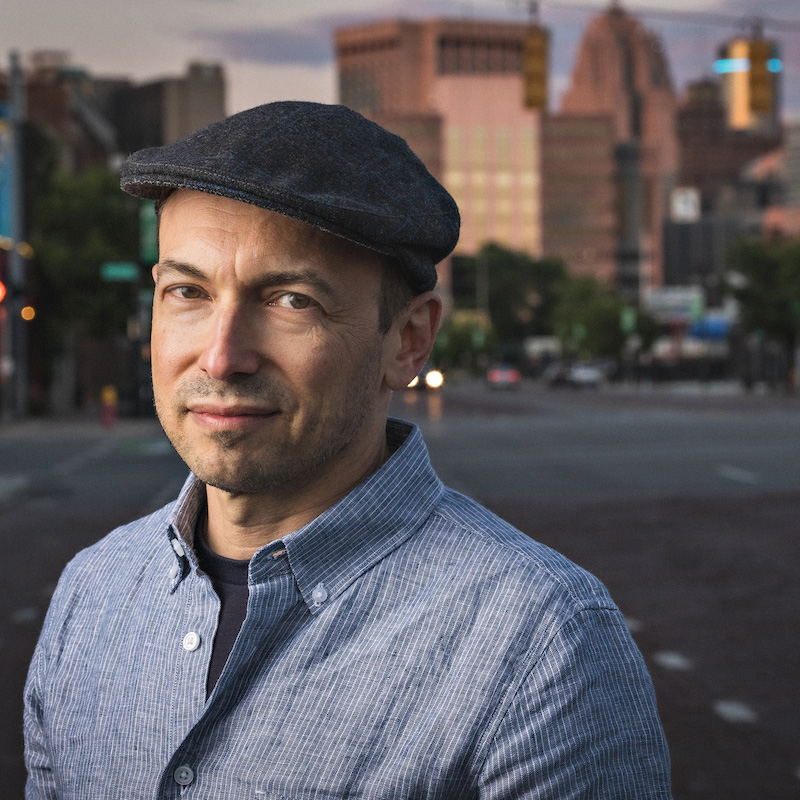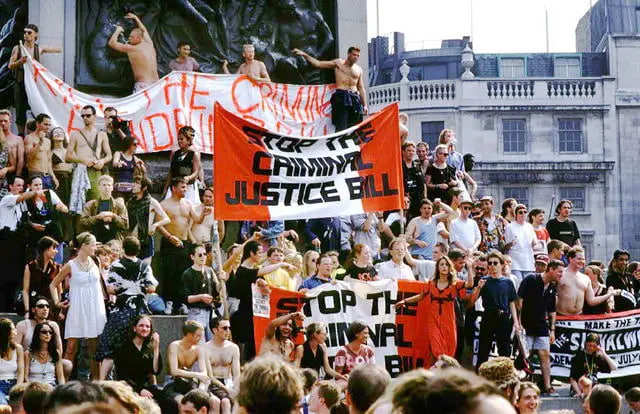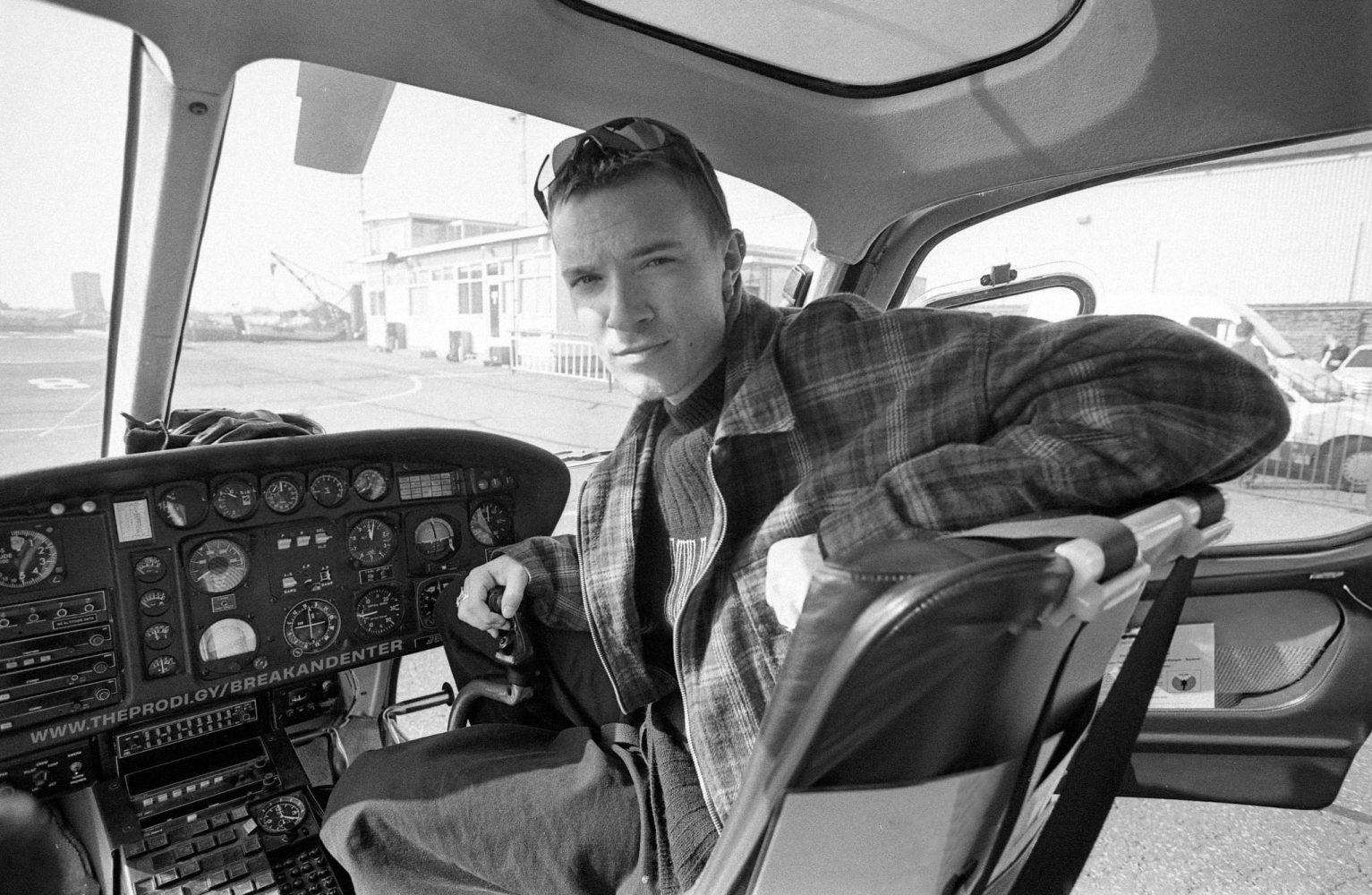#Jilted30: Intro / Break & Enter · Story
In July 2024, the iconic Music for the Jilted Generation turned 30. To mark the occasion, we’re starting a new long-running series of articles dedicated to the story of each track from The Prodigy‘s second album. We’ll go in order: in this article, we’ll share all the known facts about the album’s opening Intro, as well as the second track Break & Enter, a live performance of which still remains, for many, the quintessential atmosphere of the electronic punks’ live shows.

Music For The Jilted Generation is a true sign of the times: from start to finish, the release is filled with colorful echoes of the rebellious spirit of the early to mid-1990s, which manifests itself from the very first seconds of the album. The album’s opening epilogue (‘So I’ve decided to take my work back underground… to stop it falling into the wrong hands’) is the group’s direct response to the commercialization of rave culture: Liam Howlett, the brains and creative force behind The Prodigy, signaled a conscious retreat from mainstream pressures and a desire to preserve the raw, dirty, and unpolished essence of their music. It may seem ironic that the band’s second album became their first real commercial success, but at the same time The Prodigy cemented their status as staunch defenders of the underground.
Originally, the Essex prodigy lifted this phrase from the 1992 sci-fi thriller The Lawnmower Man. The original quote goes: ‘So I’m taking my work underground. I can’t let it fall into the wrong hands again’. It’s spoken by Dr. Lawrence Angelo (played by Pierce Brosnan), a brilliant scientist facing various moral dilemmas. At a key moment in the film, Lawrence, disillusioned by the military’s misuse of his research, blows up the institute where he conducted his experiments. His work is consumed by the flames as well.
The reaction of Brosnan’s character is quite comparable to how Liam felt in 1993–1994, as he ventured into entirely new musical territory, turning away from the so-called ‘kiddie rave’ sound familiar to fans and journalists alike (‘kiddie rave’ being how some particularly picky critics referred to the group’s style for a time).

However, it seems that the band and label either couldn’t clear the rights to this quote, or they consciously decided to rework it to better fit the spirit of the album. Richard Russell, owner of the XL Recordings label (which released the group’s music at the time), was looking for someone with an American accent to record the spoken-word sample, and the first person who came to mind was Dan Charnas.

At the time, Charnas was responsible for scouting new talents for American Recordings and would later become known as a radio host and writer. Richard and Dan were good friends, and when Charnas dropped by London briefly on business, he immediately agreed to Richard’s proposal.
Richard Russell in ‘Liberation Through Hearing’: Dan has the distinction of being the first vocal performer you hear on the album, despite having no previous (or I imagine subsequent) experience as a rave vocalist.
The album features tracks with a wide range of moods: there’s downtempo, Belgian techno, hip-hop, big beat, breakbeat hardcore, acid, and much more — yet despite this, it carries a distinct, tangible cinematic quality that, like an invisible thread, connects all the tracks together into a coherent narrative. The album’s intro sets this tone: a drawn-out sitar sample, the clacking of typewriter keys, and Dan’s relaxed voice all get you in the right frame of mind.
- Sample: ‘Intro’: tambura
- Sample source: E-mu Proteus/3 – Patches – 046 Tamburas
- Sample: ‘Intro’: fx
- Sample source: E-mu Proteus/3 – Patches – 009 Waterphone
Break & Enter
After the brief intro and the creaking door sound, the glass-shattering effect in the next track, Break & Enter, snaps you back to reality and continues this cinematic vibe, at once harking back to the Experience era while introducing listeners to an entirely new, darker side of Liam’s music.
Liam Howlett for Martin Roach: It had the feel of the rhythm section of ‘Charly’ but still very different. The beats are similar, I suppose it would have been what I could have done if I had re-mixed a long version of ‘Charly’. ‘Break And Enter’ is much longer though, a real build up but with the same flavour, a typical Prodigy tune but with a bit more. On Jilted Generation we tried to steer away from ragga too much because that worked on the first album and was okay for that era, but things move on and you have to adapt.

Interestingly, the title ‘Break & Enter’ coincides with the name of a criminal offense in England and several other countries. This is no coincidence: the album was created in the context of youth opposition to the infamous Criminal Justice Bill of 1994, and at the time, Liam was seriously angry about what was happening in the country. One of Liam’s original ideas, apparently, was to name each track on the album after an offense in England. It’s hard to say whether Liam was joking in his interview with journalist Mark Dynamix when he shared this concept, but either way, the chatter nicely illustrates how Liam was thinking at the time.
Liam Howlett for Mark Dynamix: One of the original ideas was to make it look like the actual titles of the tracks were offenses, like, you know, you’ve got an offense in England called Break and Enter, which is like when you break into a house and steal. […] So we’re gonna call each track like an offense, like, I don’t know what the other tracks are going to be called, but, you know, that type of idea. Basically, [the album] just kicks in with a kind of like a real strong first track that grabs your attention straight away, you know.
It’s also important to remember that Liam never wanted to over-politicize the group’s music. In many interviews from the mid-90s, he complained that he didn’t want to become the voice of a generation, reacting to every little thing the people in power did. He just wanted to say that one particular law was total crap. And nothing more.

A year after the album’s release, in 1995, director Neil Goodwin wanted to use ‘Break & Enter’ and other tracks from the album as a soundtrack for his film Life in the Fast Lane, which focused on protests against the construction of Britain’s M11 motorway. Liam didn’t grant permission for his music to be used: ‘Let them build their damn motorway through my fucking garden — at least I’ll get to London faster!’
Liam Howlett for Pop magazine (Sweden): If people come to our shows thinking, “Okay, here’s the song about rainforests! And here’s the song about seals!”, we’re in deep shit. I’ve never liked political messages in music. When I listen to Public Enemy, I get into the beats, not the politics.
According to ‘Electronic Punks’ book (written by Martin Roach), ‘Break & Enter’ was the first track written for the album, and each subsequent recording by Liam for the album was inspired by the previous one. Perhaps that’s why the aforementioned cinematic nature of the album feels so coherent.
The distinctive vocal, a key element of ‘Break & Enter’, was sampled from the track Casanova by Jazz & The Brothers Grimm, where the vocalist was Dorothy Fearon, who performed under the alias Baby D. For ‘Break & Enter’, Liam sampled the ‘1989 Casanova (The Rocky Remix), which opens with the clean vocal sample.
Rumor has it that after Liam asked the artists for permission to clear the sample, they, as one of the conditions, suggested he remix ‘Casanova’ — by that time, Baby D had become a separate project, and Liam’s work was released in July 1994 under the title Casanova (Prodigy Pump Action Remix), almost simultaneously with The Prodigy’s album. This is one of the few samples that’s documented in the album’s booklet.
Full story behind Liam Howlett’s remix of Casanova is already on our Patreon
The main beat of ‘Break & Enter’ is based on the track ‘Puma (Intense Remix)’ by Subwoofer Agte, released presumably in the first half of 1993. In addition, the album mix contains samples from Bobby Byrd (yeah, that iconic Hot Pants break), Hackney Hardcore, Acen, and others. It’s difficult to pinpoint exactly which synthesizers Liam used for this track, but the strings were likely played on a Roland U-220.
BREAK & ENTER: compete samples list
- Sample: beat
- Sample source: Subwoofer Agte – Puma (Intense Remix) [Hymn – Exclusive UK Remixes, 1993]
- Original source: DJ Seduction – My Own [My Own / Higher Now, 1992]
- Note: Liam added a pattern consisting of five kicks and two claps on top of the loop.
- Sample: snare #1 & tambourine
- Sample source: Bobby Byrd – Hot Pants (Bonus Beats) [I Know You Got Soul, 1988]
- Note: Liam used the snare that can be heard exactly at 0:16 in ‘Hot Pants’.
- Sample: percussion
- Sample source: Hackney Hardcore – Dance Hall Dangerous! (Version 2) [Dance Hall Dangerous!, 1991]
- Sample: scream
- Sample source: Human Being – The Box Opened (Bedroom In Space) [Straight From The Bedroom – Volume 1, 1993]
- Sample: snare #2
- Sample source: Acen – Trip II The Moon. The Darkside… [Trip II The Moon Part.. 2, 1992]
- Note: This snare sound can be heard in ‘Trip II The Moon. The Darkside…’ at 1:36 into the track.
- Sample: vocals (‘bring it down to earth, oooooh’)
- Sample source: Jazz & The Brothers Grimm featuring Baby D & MC Juice – Casanova (The Rocky Remix) [Casanova, 1990]
- Note: Liam made a remix of this track and had all the stems, however, the possibility of sampling ‘Casanova (The Rocky Remix)’ can’t be ruled out. The sample source is listed in the booklet of ‘Music For The Jilted Generation’: Track 2 sample taken from ‘Casanova’ by Baby D courtesy of Production House Records Ltd.
A few years ago, Canyon Hill, one of our team members, recreated ‘Break & Enter’ from scratch in Ableton Live, using all the found samples. Check out his version and subscribe to his YouTube channel!
Liam’s growing desire for experimentation, guitar sound, rock attributes, and even punk influences inevitably affected the performance of ‘Break & Enter’ — by the spring of 1995, just in time for the start of the new tour, the track’s sound had changed significantly from the album mix. Liam heavily altered its beat and structure, and guitarist Jim Davies, who would work with the band until 2005, joined the stage. Along with the sound, the whole live show changed too — The Prodigy opened all their 1995 performances with ‘Break & Enter’, and the track became the true trademark of their concerts.
Press release excerpt (by Chris Sharp): …As the shattered glass breakbeats of ‘Break And Enter’ ring out at huge volume and thousands of dancing people turn the entire field into one enormous moshpit, the crowd are greeted by the deranged spectacle of a flame haired Keith Flint rolling onto the stage in a massive glass ball. There was no more room for doubt – The Prodigy’s state-of-the-art fusion of dance energy, rock power, and visual madness had arrived.
The Prodigy themselves released this revamped guitar version of ‘Break & Enter’ twice. The Electronic Punks VHS, released in the summer of 1995, featured videos from several of the group’s concerts, including the fresh show opener. However, the sound on this recording leaves much to be desired: for the VHS, it was recorded from the crowd. In the Electronic Punks setlist, the new mix was labeled as Break & Enter ’95. Perhaps the most epic and high-quality recording capturing this version of the track is the video from the Glastonbury festival, which was officially released only 10 years later, in 2005, on the DVD Their Law (The Singles 1990-2005) — it’s the only professional soundboard recording of Break & Enter ’95 that has been officially released by the band.
To mark the 30th anniversary of the LP, the All Souvenirs team has recreated this version from scratch! It only lacks Jim Davies’ guitar — we hope to fix that some day 🙂
By the end of 1995, the band continued to experiment with their sound and began shaping the style that would later define The Prodigy’s third album The Fat Of The Land. In early 1996, ‘Break & Enter’ was changed once again to better fit the group’s new big beat direction: Liam reworked the beats and synths again, slightly tweaked the vocals, and Jim Davies played his part in a completely different way. This new version was titled simply New Break & Enter in the band’s setlist and existed for only a month before being shelved again.
By late 1996, the track had been reduced to a short ambient filler, played near the end of the shows: it featured only the recognizable vocal sample from Casanova, along with a few pads and synths.
A decade after the album’s release, during the ‘Their Law’ anniversary tour in 2005, Liam once again revamped ‘Break & Enter’, returning it to its role as the band’s live show opener, thereby referencing events from ten years prior. In 2008, this mix was even officially released under the title Break And Enter (2005 Live Edit): it appeared on the second CD of the More Music For The Jilted Generation reissue. Incidentally, at two British shows in 2022, in Manchester (July 19) and London (July 21), Liam used this version as a minute-long live filler.
At the beginning of 2013, ‘Break & Enter’ returned to the live setlist — this time in the form of an unexpected mashup. At three Australian shows that year, the group presented a new version of the track, initially mistaken for another remix by Liam. Later, it was revealed that this was a mashup of ‘Break & Enter’ with Emalkay’s tune Crusader. However, as it turned out, the idea wasn’t Liam’s at all.
The original concept came about in 2011, thanks to Emalkay himself (real name: Martin Knowles). He introduced his version in one of his mixes recorded for MistaJam’s BBC radio show: at the time, the track appeared under the title Emalkay Vs The Prodigy – Crusade And Enter (Mash Up) — later, Martin played the track at his live shows as well. Eventually, Liam liked Emalkay’s idea so much that he slightly reworked Knowles’ mashup and played it at several shows to add some variety to The Prodigy’s live setlist.
Emalkay for UKF: The first record I actually bought myself was The Prodigy’s Fat Of The Land. I’m definitely proud of that first music purchase. It played a hugely influential role in my musical tastes and eventually led to where I am today. Actually I’m proud of every musical investment I’ve ever made. If I’m going to part with my money then I make sure I’m doing it wisely!
In the next article, we’ll be publishing our exclusive interview with Pop Will Eat Itself — they recorded the basis for the legendary ‘Their Law’, later reworked by Liam for ‘Music for the Jilted Generation’ and becoming one of the band’s biggest hits. PWEI shared with us every detail about how the track was created…
Headmasters: SIXSHOT, SPLIT
Additional thanks to: Canyon Hill
Donate
- Tether (USDT)
Donate Tether(USDT) to this address


